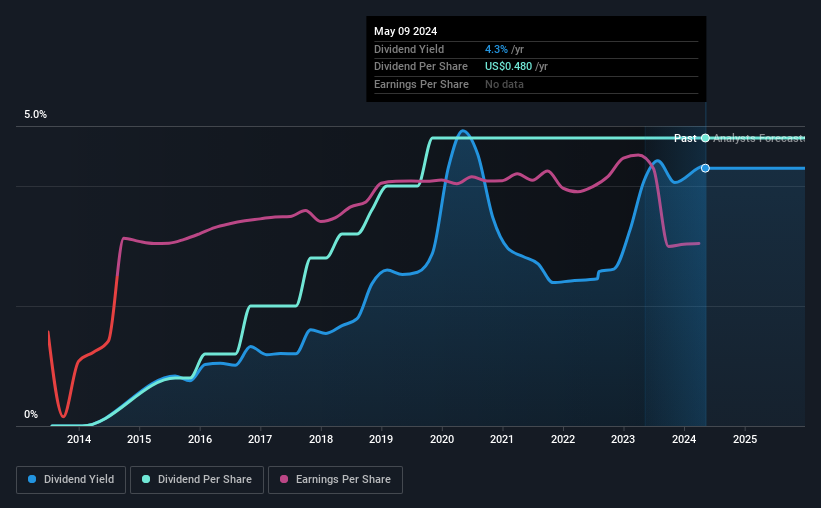Stock Analysis
- United States
- /
- Banks
- /
- NasdaqGS:SHBI
Here's Why We're Wary Of Buying Shore Bancshares' (NASDAQ:SHBI) For Its Upcoming Dividend

It looks like Shore Bancshares, Inc. (NASDAQ:SHBI) is about to go ex-dividend in the next four days. Typically, the ex-dividend date is one business day before the record date which is the date on which a company determines the shareholders eligible to receive a dividend. The ex-dividend date is important as the process of settlement involves two full business days. So if you miss that date, you would not show up on the company's books on the record date. Therefore, if you purchase Shore Bancshares' shares on or after the 15th of May, you won't be eligible to receive the dividend, when it is paid on the 31st of May.
The company's next dividend payment will be US$0.12 per share, and in the last 12 months, the company paid a total of US$0.48 per share. Based on the last year's worth of payments, Shore Bancshares stock has a trailing yield of around 4.3% on the current share price of US$11.17. Dividends are a major contributor to investment returns for long term holders, but only if the dividend continues to be paid. As a result, readers should always check whether Shore Bancshares has been able to grow its dividends, or if the dividend might be cut.
See our latest analysis for Shore Bancshares
Dividends are typically paid from company earnings. If a company pays more in dividends than it earned in profit, then the dividend could be unsustainable. Shore Bancshares distributed an unsustainably high 111% of its profit as dividends to shareholders last year. Without more sustainable payment behaviour, the dividend looks precarious.
Generally, the higher a company's payout ratio, the more the dividend is at risk of being reduced.
Click here to see the company's payout ratio, plus analyst estimates of its future dividends.

Have Earnings And Dividends Been Growing?
Companies with falling earnings are riskier for dividend shareholders. If earnings decline and the company is forced to cut its dividend, investors could watch the value of their investment go up in smoke. Shore Bancshares's earnings per share have fallen at approximately 21% a year over the previous five years. Ultimately, when earnings per share decline, the size of the pie from which dividends can be paid, shrinks.
The main way most investors will assess a company's dividend prospects is by checking the historical rate of dividend growth. In the last nine years, Shore Bancshares has lifted its dividend by approximately 22% a year on average. The only way to pay higher dividends when earnings are shrinking is either to pay out a larger percentage of profits, spend cash from the balance sheet, or borrow the money. Shore Bancshares is already paying out a high percentage of its income, so without earnings growth, we're doubtful of whether this dividend will grow much in the future.
Final Takeaway
Is Shore Bancshares worth buying for its dividend? Not only are earnings per share shrinking, but Shore Bancshares is paying out a disconcertingly high percentage of its profit as dividends. Generally we think dividend investors should avoid businesses in this situation, as high payout ratios and declining earnings can lead to the dividend being cut. Shore Bancshares doesn't appear to have a lot going for it, and we're not inclined to take a risk on owning it for the dividend.
Having said that, if you're looking at this stock without much concern for the dividend, you should still be familiar of the risks involved with Shore Bancshares. Every company has risks, and we've spotted 4 warning signs for Shore Bancshares (of which 1 is concerning!) you should know about.
A common investing mistake is buying the first interesting stock you see. Here you can find a full list of high-yield dividend stocks.
Valuation is complex, but we're helping make it simple.
Find out whether Shore Bancshares is potentially over or undervalued by checking out our comprehensive analysis, which includes fair value estimates, risks and warnings, dividends, insider transactions and financial health.
View the Free AnalysisHave feedback on this article? Concerned about the content? Get in touch with us directly. Alternatively, email editorial-team (at) simplywallst.com.
This article by Simply Wall St is general in nature. We provide commentary based on historical data and analyst forecasts only using an unbiased methodology and our articles are not intended to be financial advice. It does not constitute a recommendation to buy or sell any stock, and does not take account of your objectives, or your financial situation. We aim to bring you long-term focused analysis driven by fundamental data. Note that our analysis may not factor in the latest price-sensitive company announcements or qualitative material. Simply Wall St has no position in any stocks mentioned.
About NasdaqGS:SHBI
Shore Bancshares
Operates as a bank holding company for the Shore United Bank, N.A.
Flawless balance sheet with high growth potential.


